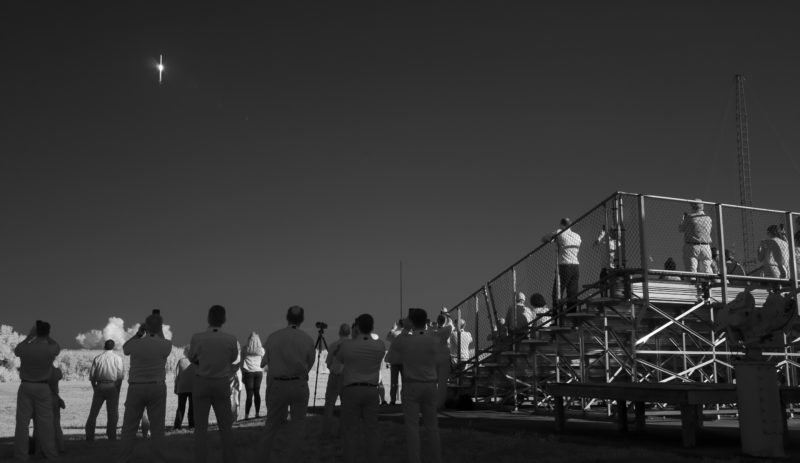
Laden with 8,200 pounds (3,700 kg) of payloads and supplies, Northrop Grumman Corp.’s NG-16 Cygnus cargo ship—named in honor of shuttle Challenger hero Ellison Onizuka, the first Asian-American astronaut—is zeroing-in on a berth at the International Space Station (ISS), following its late afternoon launch Tuesday from Pad 0A at the Mid-Atlantic Regional Spaceport (MARS) on Wallops Island, Va. The station was approximately 260 miles (420 km) above the Indian Ocean at the instant of liftoff.
Onizuka becomes the first member of the “Challenger Seven” to be so honored with an ISS-bound cargo ship in his memory. Previous spacecraft in the Cygnus fleet have already recognized two Columbia astronauts and one member of the ill-fated Apollo 1 crew.
Liftoff of the 133-foot-tall (40.5-meter) Antares 230+ booster took place right at the end of a five-minute “launch window” at 6:01:05 p.m. EDT, following a Ground Support Equipment (GSE) issue with a helium pressurization valve. Cygnus was successfully inserted into low-Earth orbit about nine minutes after liftoff.
Following an automated two-day rendezvous, it will be grappled about 6:10 a.m. EDT Thursday by the station’s 57.7-foot-long (17.6-meter) Canadarm2 and berthed at the Earth-facing (or “nadir”) port of the Unity node for a three-month stay.
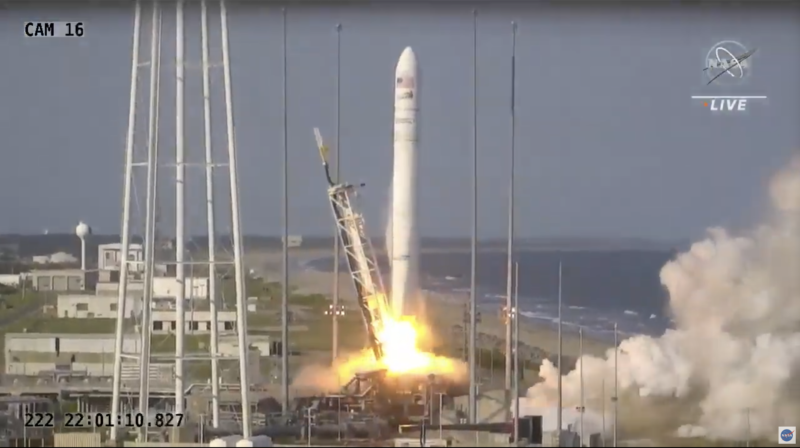
Affectionately nicknamed “Sweet Sixteen” by Frank DeMauro, Northrop Grumman’s vice president and general manager of tactical space systems, NG-16 is actually the 17th Cygnus to have been launched since September 2013, when one counts the initial ORD-D “demonstration” mission and the 16 “dedicated” flights which followed in its wake between January 2014 and earlier this year.
However, one mission—the ill-fated ORB-3 in October 2014—was lost when its Antares rocket catastrophically exploded, seconds after liftoff. As such, a successful rendezvous and berthing on Thursday will make NG-16 the 16th Cygnus to arrive safely and deliver its payload to the station.
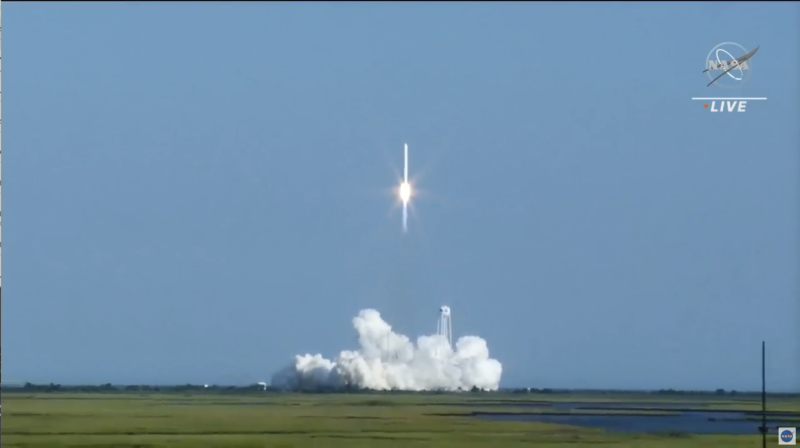
And Tuesday’s liftoff marks the tenth straight successful launch by an Antares since October 2016. It is also the fifth of six missions under the second-round Commercial Resupply Services (CRS2) contract with NASA, although two more flights were added last spring. This extends Northrop Grumman’s CRS2 commitment into 2023.
In a media teleconference yesterday afternoon, ISS Program Manager Joel Montalbano outlined the successful completion of the Launch Readiness Review (LRR) earlier Monday and Wallops Range Antares Project Manager Brittany McKinley presented a highly optimistic weather forecast for three consecutive days of launch attempts.
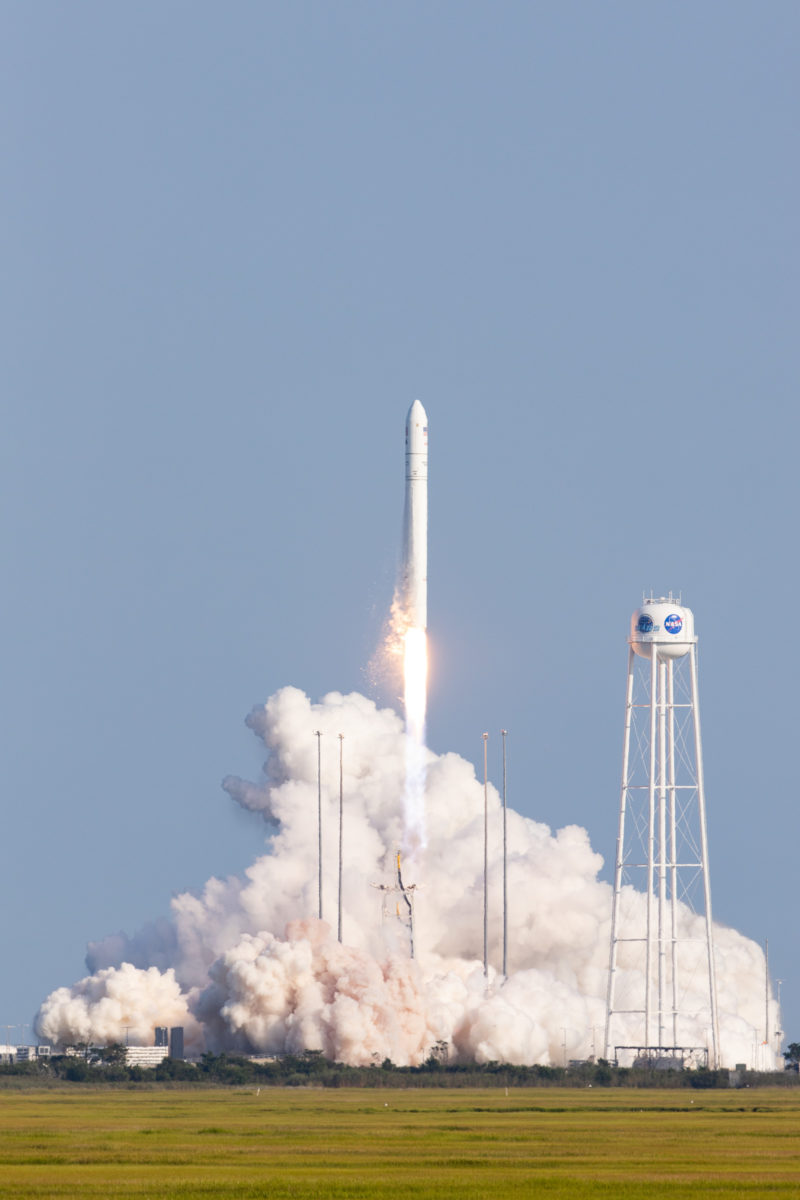
Tuesday’s opening opportunity was expected to be 80-percent-favorable, with only a slight risk of infringing the Cumulus Cloud Rule, with a slight downturn to 70 percent on Wednesday and Thursday, thanks to the added chance of violating the Anvil Cloud Rule.
As the final minutes of the countdown ticked away, temperatures at the pad reached 27 degrees Celsius (82 degrees Fahrenheit) and the skies along the Virginia Coast were bright and sunny, increasing the probability of acceptable weather up to 90 percent.
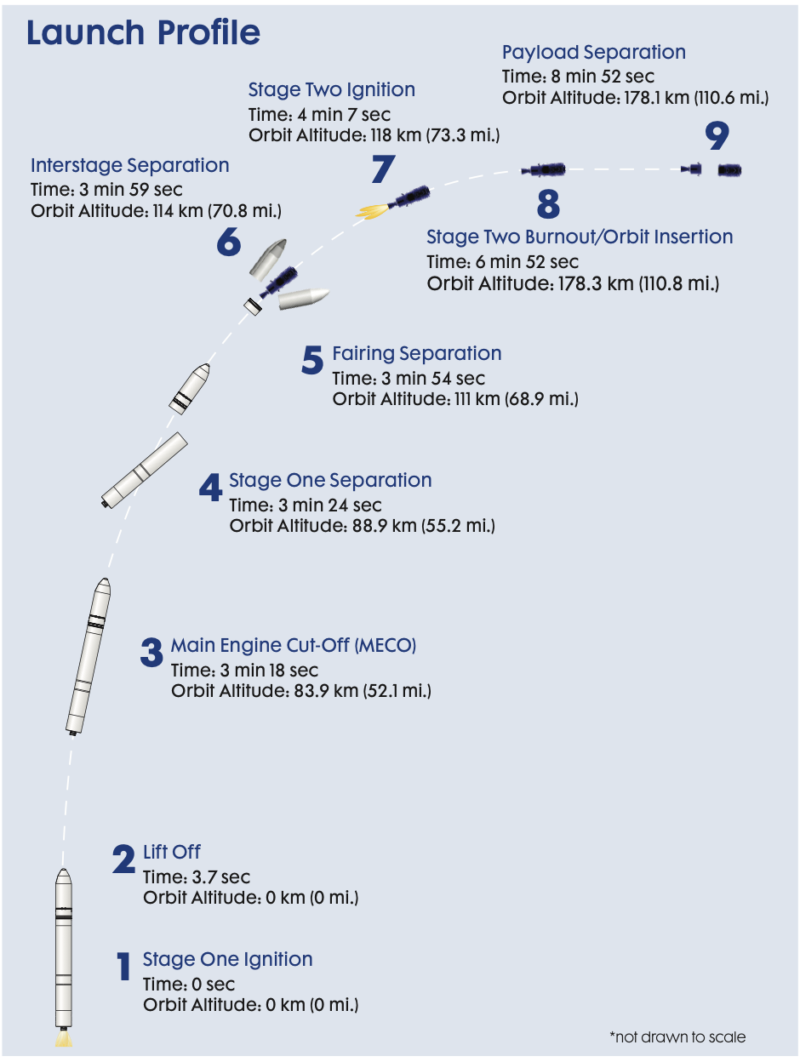
As detailed in AmericaSpace’s preview article, NG-16 is carrying more than 8,200 pounds (3,700 kg) of payloads, equipment and supplies to the station’s seven-person Expedition 65 crew, which Mr. DeMauro described as the “heaviest cargo delivery load” of any Cygnus to date.
He also paid touching tribute to Ellison Onizuka, the Air Force lieutenant-colonel of Japanese heritage who became the first Asian-American astronaut when he flew shuttle Discovery on the highly secretive STS-51C mission in January 1985.
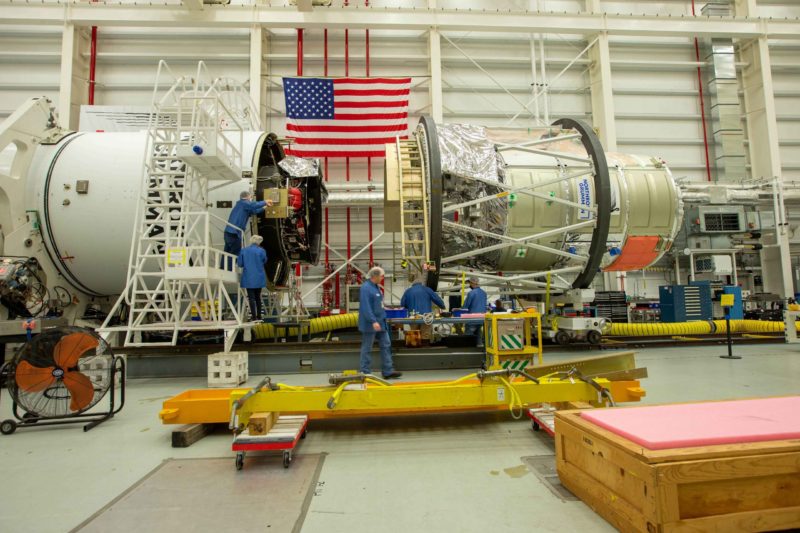
A year later, Onizuka tragically lost his life—alongside STS-51L crewmates Dick Scobee, Mike Smith, Judy Resnik, Ron McNair, Greg Jarvis and civilian schoolteacher Christa McAuliffe—when shuttle Challenger was destroyed, only 73 seconds after launch. In a touching comment, Mr. DeMauro called Onizuka a “shining example” of someone who proved that racial barriers and glass ceilings are there to be broken.
The Pressurized Cargo Module (PCM) for the NG-16 Cygnus was integrated with its Service Module (SM) last month, prior to installation atop the Antares 230+ booster. The complete “stack” was rolled horizontally out to Pad 0A last weekend and elevated to the vertical for final checks.
Yesterday, it was briefly returned to a horizontal configuration at the pad to enable time-critical “Late Load” items to be packed aboard the Cygnus. This process was achieved by means of a specialized fairing (nicknamed the “pop-top”), which afforded Northrop Grumman engineers access to the PCM’s expansive interior.
Early Tuesday, engineers and flight controllers came to their Wallops consoles to begin powering up the booster and chilling its propellant systems with liquid nitrogen. Tanking was critically timed in order to adhere to temporal limits associated with the rapid boil-off of Antares’ cryogenic oxygen.
A final poll of flight controllers occurred in two phases and by T-15 minutes all of the rocket’s propellant tanks had reached flight pressure and were verified at “Flight Ready” levels. Shortly afterwards, the vehicle transferred to Internal Power and at T-11 minutes the Transporter-Erector-Launcher (TEL) was armed to effect a rapid retraction when the clock hit T-0.
Fueled by a mixture of liquid oxygen and a highly refined form of rocket-grade kerosene, known as “RP-1”, Antares took flight at 6:01:05 p.m. EDT Tuesday, not long before local sunset. The first stage’s pair of Russian-built RD-181 engines powered the booster smoothly away from the pretty seaside environs of the Virginia Coast, burning fiercely for 200 seconds before shutting down on time.
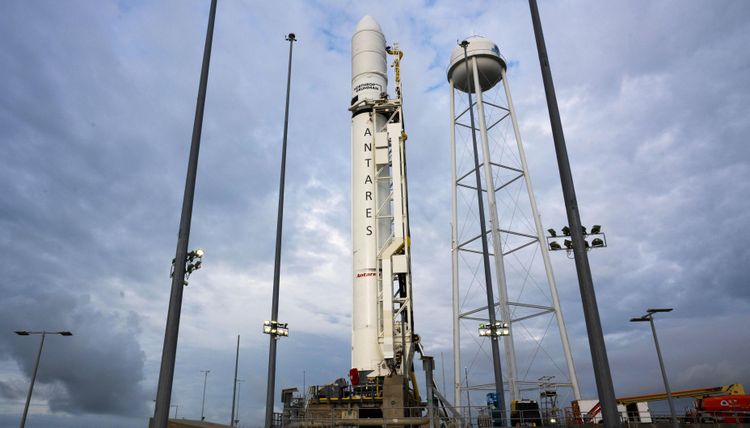
The first stage was then jettisoned and, following a 50-second “coast phase”, the solid-fueled Castor-30XL upper stage motor fired for 2.5 minutes to propel the NG-16 Cygnus into low-Earth orbit. It marked the 15th flight of Antares since April 2013 and, when one counts the ORB-3 failure, is the tenth straight successful launch by the rocket.
Seventy minutes after leaving MARS, Cygnus’ fan-like UltraFlex solar arrays were due to be deployed after which the spacecraft would settle down for an approximately 48-hour chasedown of the space station.
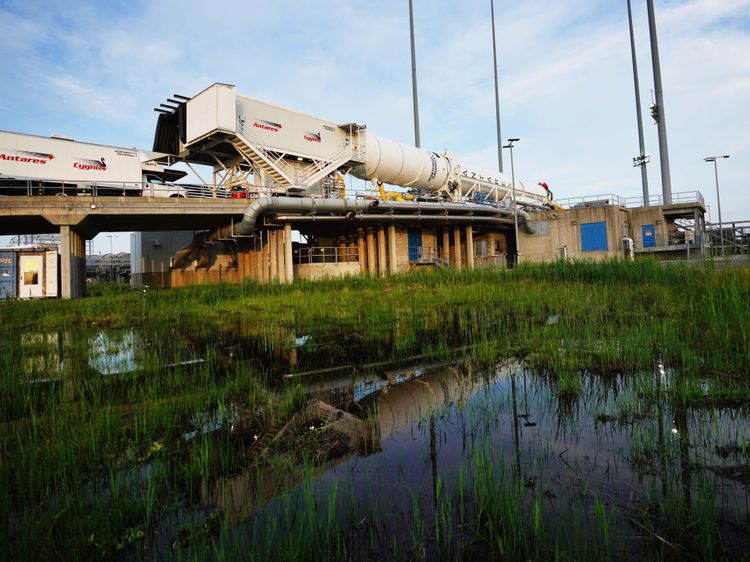
Early Thursday morning, with U.S. astronaut Megan McArthur at the controls of Canadarm2 and French crewmate Thomas Pesquet backing her up in a monitoring role, the cargo ship will complete its rendezvous. It will approach its first “Hold Point” at a distance of 820 feet (250 meters) from the ISS.
Following approval to proceed, it will move inside the “Keep Out Sphere” (KOS), a virtual exclusion zone which extends 660 feet (200 meters) around the station to circumvent any risk of collision. Passing a second Hold Point at 100 feet (30 meters), Cygnus will then move to its final Capture Point at 30 feet (10 meters), whereupon McArthur and Pesquet will be given a “Go for Capture”.
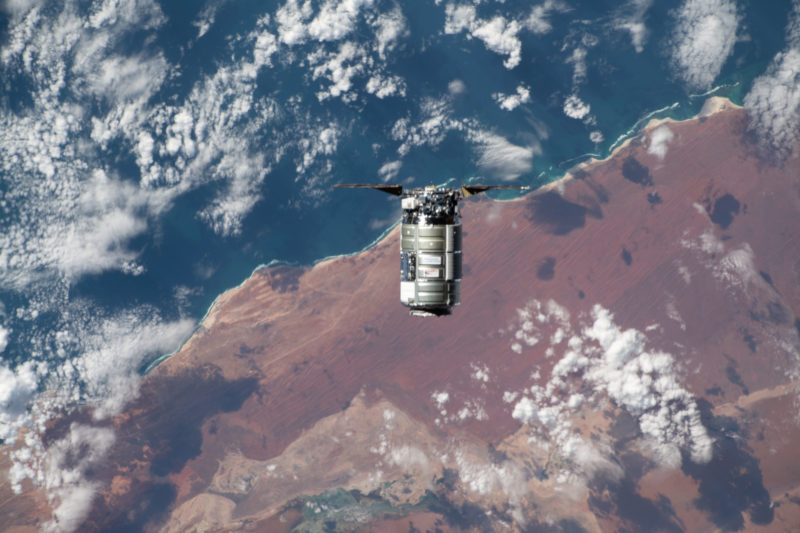
Grapple of the cargo ship is due to occur at about 6:10 a.m. EDT and it will be berthed at the nadir port of the Unity node a couple of hours later.
Berthing occurs in a two-step manner. First Stage Capture will see hooks from Unity’s nadir-mounted Common Berthing Mechanism (CBM) extend and engage with Cygnus, after which Second Stage Capture will see a series of 16 bolts—four gangs of four bolts each—being driven to rigidize the two vehicles into a tight mechanized embrace.
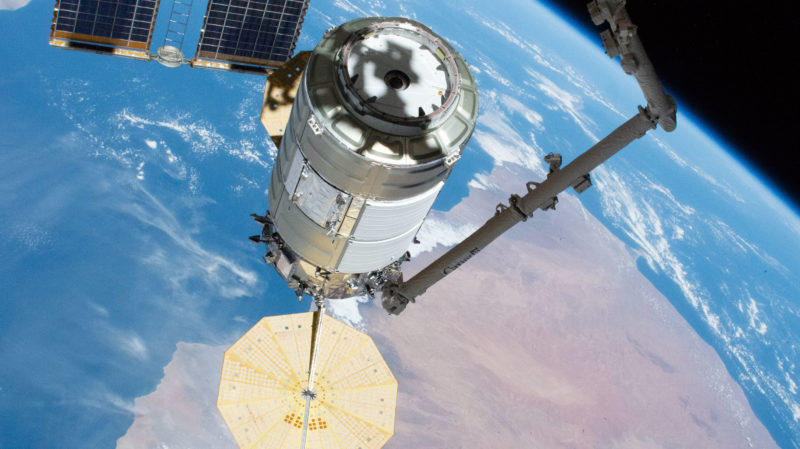
Although McArthur previously supported the departure of the most recent Cygnus in late June, this will be her first time in the key role of grappling an incoming cargo ship. Pesquet, on the other hand, previously participated in the departure of the OA-5 Cygnus in November 2016 and led the arrival and berthing of the OA-7 Cygnus in April 2017.
With Thursday’s arrival of the NG-16 Cygnus, a total of four visiting vehicles will reside at the ISS. Longest-lasting is Soyuz MS-18, which delivered Russian cosmonauts Oleg Novitsky and Pyotr Dubrov, together with NASA astronaut Mark Vande Hei, in the second week of April.
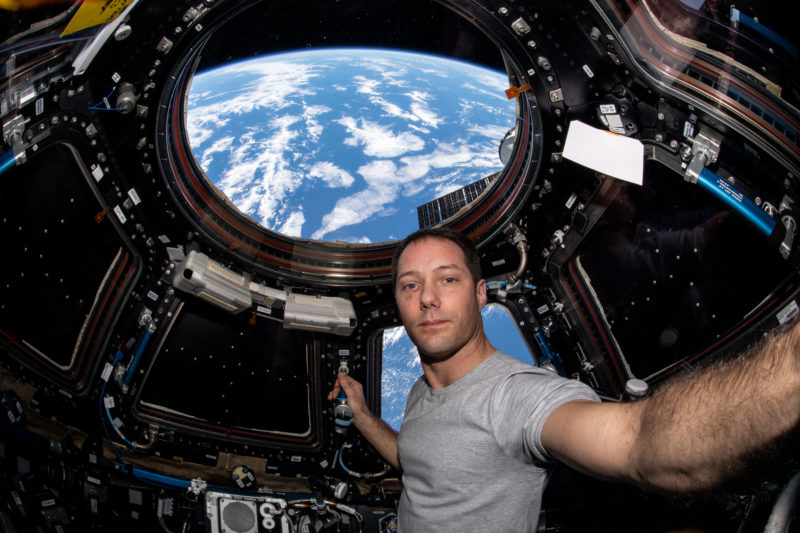
In second place is SpaceX’s Dragon Endeavour, which on 23 April ferried the Crew-2 quartet of McArthur, Pesquet, U.S. astronaut Shane Kimbrough and Japan’s Aki Hoshide to the station. Most recently, in late June, Russia’s uncrewed Progress MS-17 cargo ship launched from Baikonur in Kazakhstan and docked a few days later.
Assuming an on-time capture of Cygnus, Mr. Montalbano expects hatches to be opened into the cargo ship about eight hours later, roughly 2 p.m. EDT Thursday. This will allow the Expedition 65 crew to begin unloading its cargo, which—as outlined in AmericaSpace’s NG-16 preview article yesterday—is expected to contribute to around 250 research investigations over the next few months.
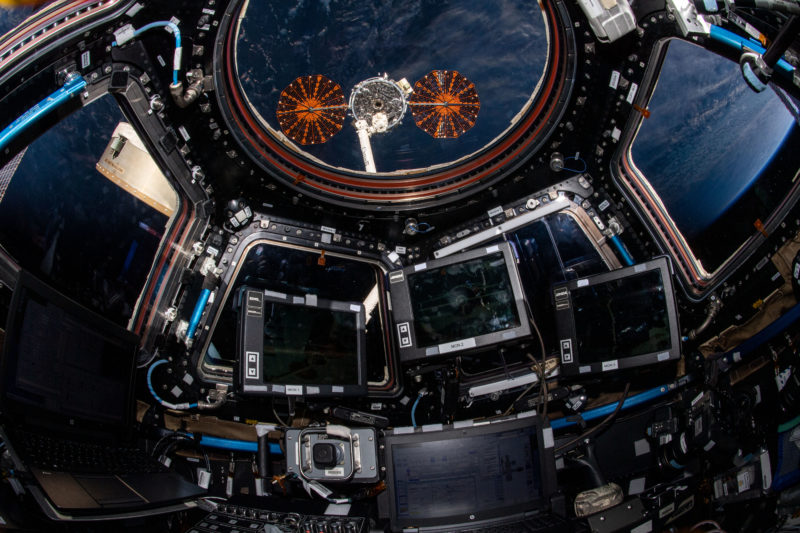
Cygnus is also carrying treats for the crew, including apples, tomatoes and kiwis, as well as kits to craft their own homemade pizzas. Additionally, a “modification kit” for the second ISS Roll-Out Solar Array (iROSA) is aboard Cygnus and is due to be installed by spacewalkers Aki Hoshide and Mark Vande Hei onto the station’s P-4 truss as early as 25 August.
Although the array itself is not due to arrive until next year, Mr. Montalbano told AmericaSpace that the early installation of the “mod-kit” will hedge against the possibility of future difficulties.
After its arrival on Thursday, the mod-kit will be temporarily stowed aboard the Cygnus, until it is transferred and assembled in the Crew Lock of the station’s Quest airlock.
Meanwhile, in the 300-foot-tall (90-meter) Vertical Integration Facility (VIF) at Space Launch Complex (SLC)-41 at Cape Canaveral Space Force Station, Fla., efforts are ongoing to understand anomalous propulsion system valve issue in Boeing’s CST-100 Starliner spacecraft.
Stacked atop a 172-foot-tall (52.4-meter) Atlas V booster, the Starliner is being readied for the its long-awaited OFT-2 mission—a second uncrewed Orbital Flight Test of the spacecraft—following the troubled OFT-1 in December 2019.
However, the OFT-2 launch has twice been scuppered in recent days. An initial launch attempt targeted for Friday, 30 July was called off due to problems experienced following last month’s arrival of the Russian Nauka (“Science”) lab at the ISS and again on Tuesday, 3 August due to “unexpected valve position indications” in Starliner’s propulsion system. These indications materialized in the final hours of Tuesday’s countdown.
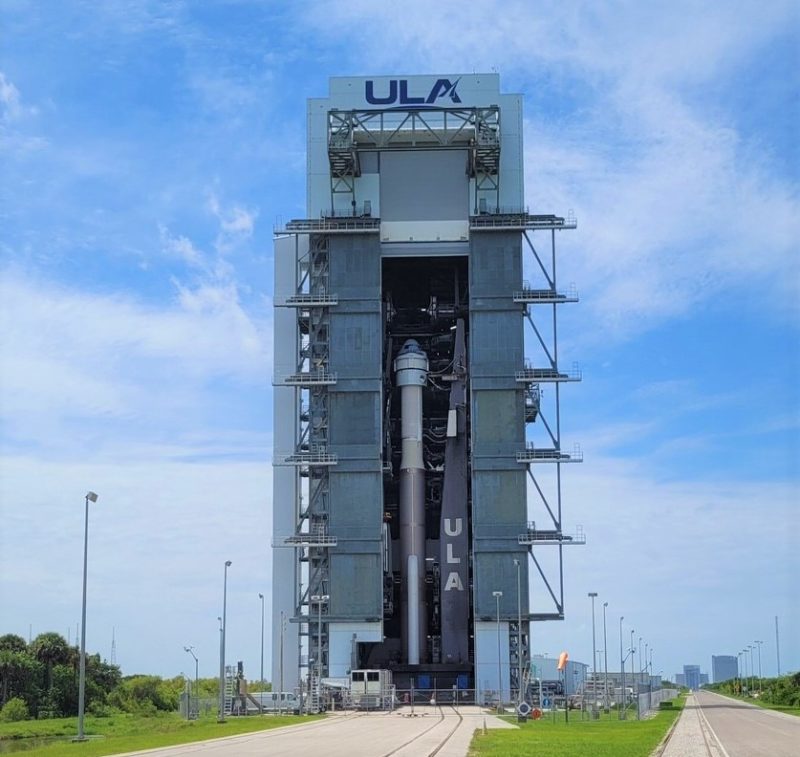
In response to this issue, the 172-foot-tall (52.4-meter) Atlas V booster was returned to the Vertical Integration Facility (VIF) at SLC-41 to afford engineers better access to the spacecraft for troubleshooting.
According to NASA in a Friday afternoon update, the valves unexpectedly declared themselves “closed” and did not transition to “open” as they should have done. The valves are part of the Starliner’s propulsion system and play an important role both in on-orbit maneuvers and launch-abort situations.
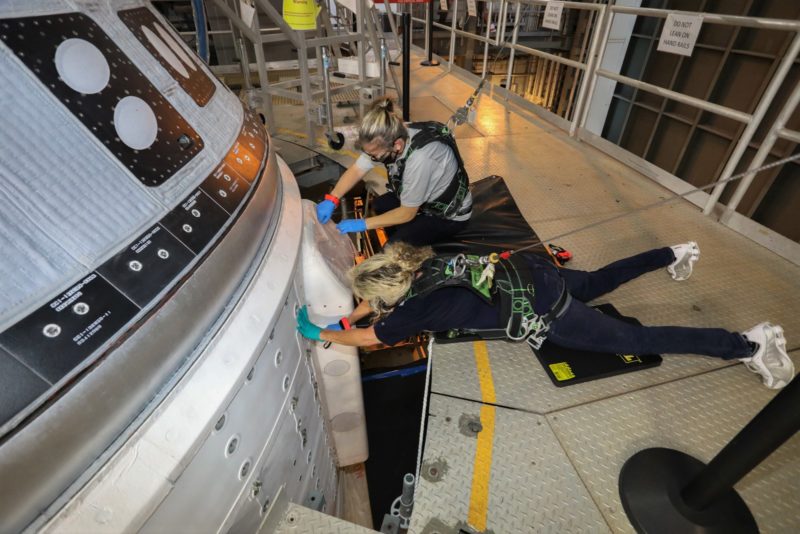
On Monday, inside the VIF, Boeing successfully commanded “open” seven of the 13 valves which had previously indicated closed. Test teams continue to apply mechanical, electrical and thermal methodologies to prompt the valves to open “and are moving forward with a systematic plan to open the remainder of the affected valves, demonstrate repeatable system performance and verify the root cause of the issue”.
According to NASA, the earliest possible launch date for OFT-2 would arise in the mid-August timeframe.
FOLLOW AmericaSpace on Facebook and Twitter!
Missions » ISS » COTS » CYGNUS »



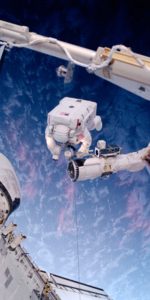
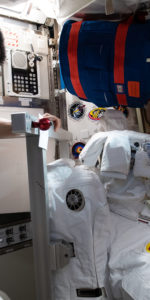
4 Comments
4 Pings & Trackbacks
Pingback:After Month at Space Station, CRS-23 Dragon Undocks, Heads Home « AmericaSpace
Pingback:After Month at Space Station, CRS-23 Dragon Undocks, Heads Home
Pingback:After Month at House Station, CRS-23 Dragon Undocks, Heads Dwelling « AmericaSpace - Technology News
Pingback:Crew-2 Returns Home, Wraps Up Longest Single Mission by U.S. Crewed Spacecraft – AmericaSpace